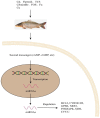Profiling miRNAs of Teleost Fish in Responses to Environmental Stress: A Review
- PMID: 36979079
- PMCID: PMC10045198
- DOI: 10.3390/biology12030388
Profiling miRNAs of Teleost Fish in Responses to Environmental Stress: A Review
Abstract
miRNAs are a class of endogenous and evolutionarily conserved noncoding short RNA molecules that post-transcriptionally regulate gene expression through sequence-specific interactions with mRNAs and are capable of controlling gene expression by binding to miRNA targets and interfering with the final protein output. The miRNAs of teleost were firstly reported in zebrafish development, but there are recent studies on the characteristics and functions of miRNAs in fish, especially when compared with mammals. Environmental factors including salinity, oxygen concentration, temperature, feed, pH, environmental chemicals and seawater metal elements may affect the transcriptional and posttranscriptional regulators of miRNAs, contributing to nearly all biological processes. The survival of aquatic fish is constantly challenged by the changes in these environmental factors. Environmental factors can influence miRNA expression, the functions of miRNAs and their target mRNAs. Progress of available information is reported on the environmental effects of the identified miRNAs, miRNA targets and the use of miRNAs in fish.
Keywords: environment factors; environment stress; fish; miRNA; target mRNA.
Conflict of interest statement
The authors declare that they have no competing interest.
Figures






References
Publication types
Grants and funding
LinkOut - more resources
Full Text Sources

